Key takeaways:
- Effective service recovery involves genuine empathy, timely communication, and exceeding customer expectations, turning negative experiences into positive relationships.
- Customer experience significantly influences loyalty; small gestures, such as remembering individual preferences, can have a lasting impact.
- Measuring recovery success through feedback surveys and net promoter scores helps refine strategies and enhance customer satisfaction.
- Real-life examples demonstrate that thoughtful responses to service failures can foster loyalty and appreciation among customers.
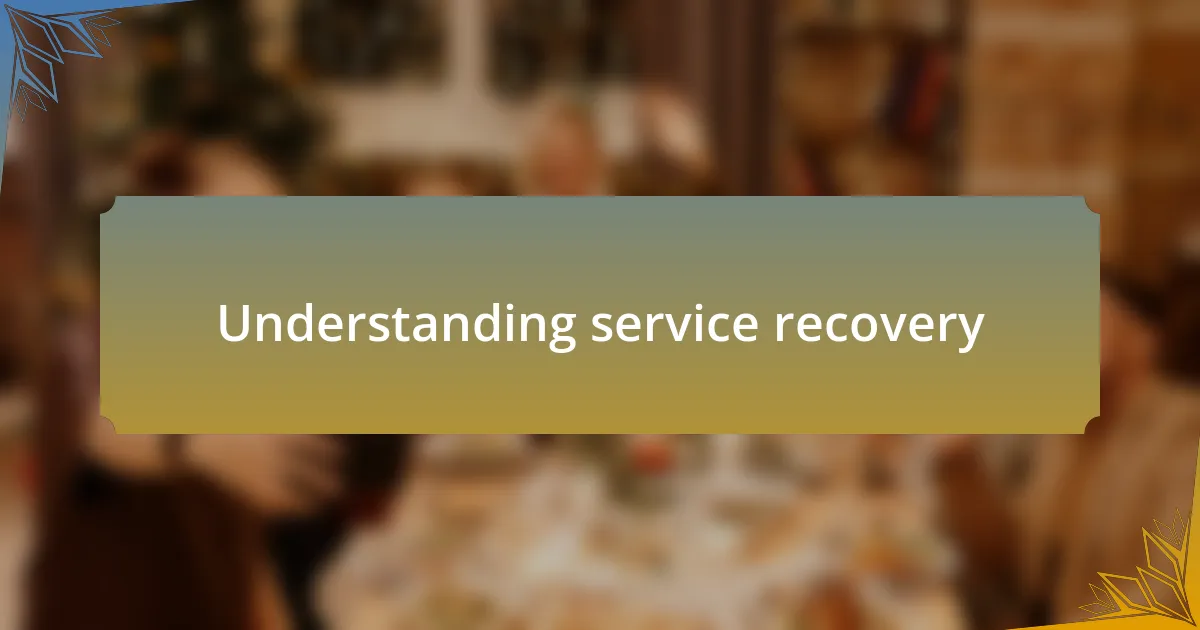
Understanding service recovery
Service recovery, at its core, is about managing the aftermath of a service failure. I remember a time when my favorite restaurant mixed up my order. Initially frustrated, the way they handled my concern turned my irritation into appreciation. They didn’t just apologize; they offered a complimentary dessert and promised to rectify my order. This made me realize that effective service recovery can transform a negative experience into a positive connection.
When a customer faces an issue, how the business responds can either build loyalty or drive them away. I’ve seen companies that simply brush off complaints, which only fuels disappointment. On the other hand, I find that those who listen—who genuinely empathize—instantly turn the situation around. It’s fascinating how a sincere acknowledgment of a mistake can create a deeper trust between the brand and its customers.
Ultimately, service recovery isn’t just about fixing a problem; it’s about creating a dialogue. I often ask myself: have I ever made an unfair judgment about a brand based on a single misstep? The truth is, many of us have. Understanding that recovery can be an opportunity to showcase a brand’s commitment to its customers might just encourage businesses to invest more in their recovery strategies.

Importance of customer experience
Customer experience is crucial because it shapes how customers perceive a business, influencing their loyalty and future interactions. I recall a time when a friendly barista at my local coffee shop remembered my usual order. That small gesture made my day, and I often find myself returning, not just for the coffee, but for the connection. How powerful is it to know that a brand values you as an individual?
When businesses prioritize customer experience, they reap multiple benefits—improved retention rates and increased word-of-mouth referrals, to name a few. I’ve noticed that companies that actively seek feedback often cultivate a community of loyal advocates. Reflecting on my experiences, it’s clear that customers want to feel heard and valued. Isn’t it remarkable how a simple conversation can lead to lasting relationships?
Moreover, the emotional impact of customer experience can’t be understated. During a recent trip, I encountered delays with flight services. Although frustrated, the airline staff’s effort to keep us informed and supported transformed my irritation into understanding. This taught me that positive experiences often emerge from how a brand handles unexpected challenges. Don’t you think that cultivating a memorable experience transcends the transaction itself?
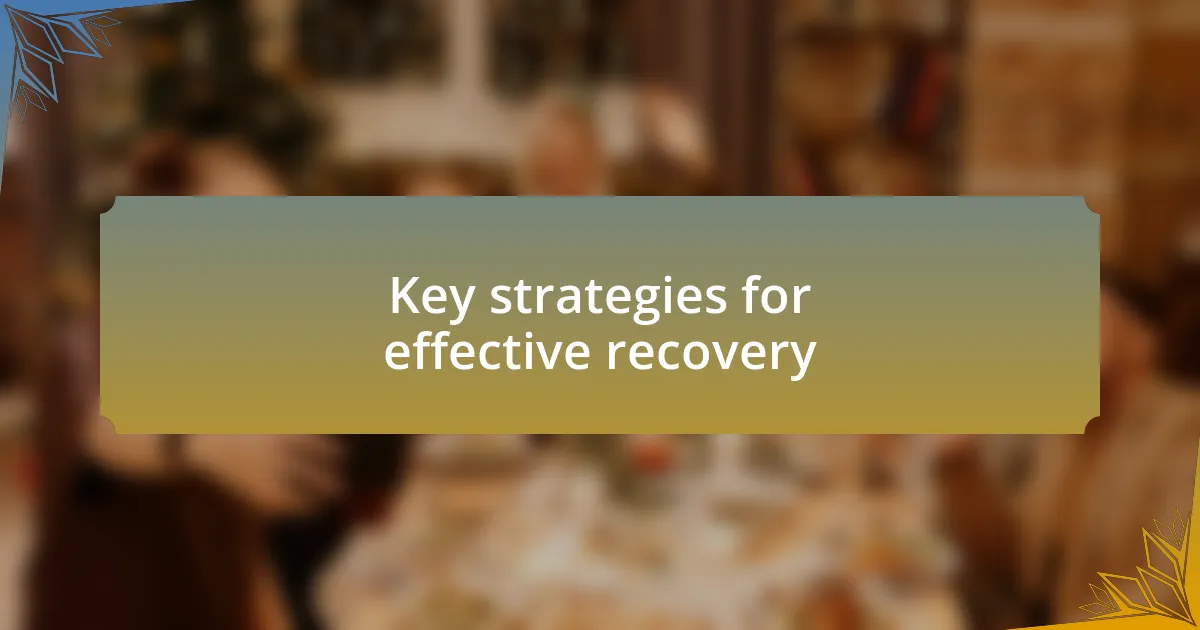
Key strategies for effective recovery
One effective strategy for service recovery is to empathize genuinely with the customer’s situation. I remember a time when my dinner order was completely wrong at a restaurant. Instead of just apologizing, the manager sat with me, listened to my concerns, and offered a complimentary meal. That personal touch made all the difference. Have you ever noticed how a simple act of understanding can turn a frustrating situation into a positive experience?
Another key approach is to provide timely and transparent communication. I recall a situation where my internet service was down, and the company sent regular updates about the issue. They acknowledged the inconvenience and assured me that they were working hard to resolve it. This openness helped me feel more patient and reassured. Isn’t it fascinating how being kept in the loop can significantly alter our perception of service recovery?
Finally, going above and beyond in offering compensation can truly enhance recovery efforts. Once, a hotel accidentally double-booked my room, and while I initially felt disappointed, they upgraded me to a suite for the inconvenience and included a gift card for dinner. That extra effort not only salvaged my stay but actually turned it into a memorable experience. Doesn’t it make you think that the effort taken to exceed expectations can transform a mishap into an exceptional customer experience?
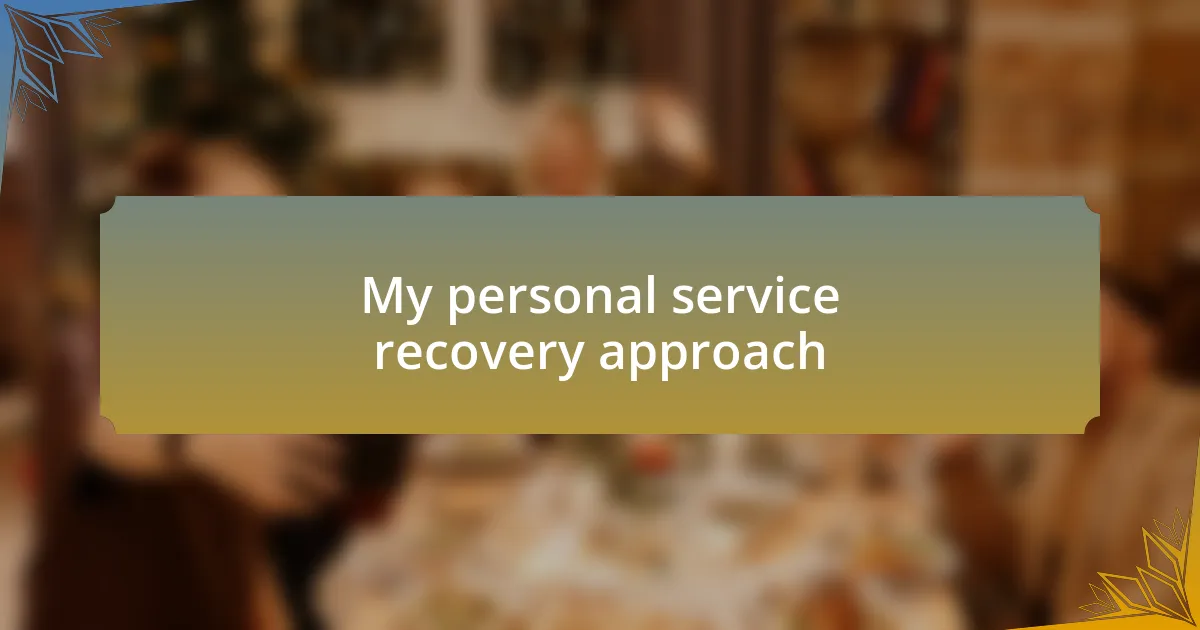
My personal service recovery approach
When it comes to my personal service recovery approach, I focus on active listening. There was an instance at a coffee shop where my drink wasn’t prepared as I ordered. Instead of just rushing to fix it, the barista paused, asked me to elaborate on what I wanted, and even offered to recreate it while discussing my preferences. I left that day not just with my coffee but feeling valued in the process. Have you ever felt truly heard in a moment like that?
I also believe in the power of sincerity in apologizing. I once faced a frustrating delay with an airline, and the gate agent didn’t just say, “Sorry for the inconvenience.” Instead, they expressed genuine regret and shared the reasons for the delay. I could sense that they cared about our experience, which deflated my irritation. Doesn’t it strike you how a heartfelt apology can set the tone for what follows?
Lastly, I find that personalized follow-up can significantly enhance the recovery process. After a service mishap at a local store, I received a handwritten note from the manager thanking me for my understanding and offering a discount on my next purchase. That small gesture made me feel like more than just a transaction; it made me a loyal customer. Isn’t it interesting how a little attention to detail can enrich our experiences as consumers?
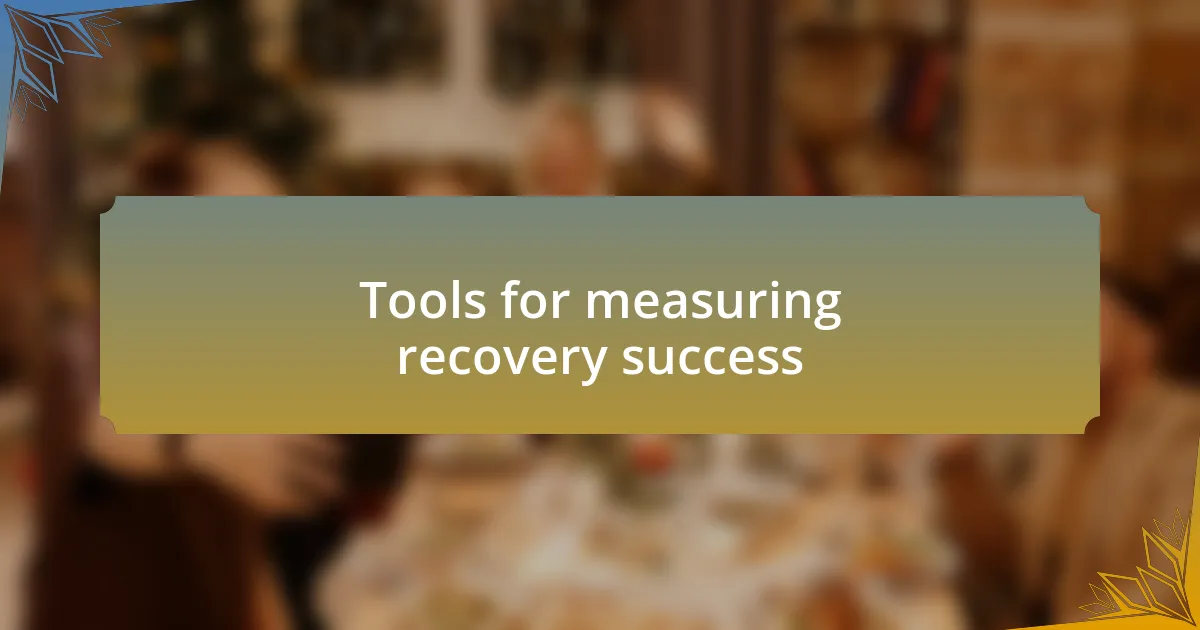
Tools for measuring recovery success
Measuring recovery success is essential for refining service strategies, and I’ve found that customer feedback surveys can be invaluable. After a recent service hiccup at a restaurant, I filled out a brief survey that specifically asked about how well the staff handled my issue. They later used that data to adjust their training programs, which impressed me and made me feel like my opinion truly mattered. Have you ever wondered how your feedback shapes the experiences of others?
Another tool that I’ve seen make a real impact is tracking net promoter scores (NPS). I remember when a hotel I stayed at introduced this metric post-recovery. After they resolved a booking error with remarkable service, I was asked if I’d recommend them to friends. It was a simple question, but it reinforced my loyalty and highlighted how they gauge their success based on actual customers’ willingness to advocate for their brand. Isn’t it powerful to think that your preference can influence a business’s direction?
Additionally, social media listening tools have become an eye-opener in recovery assessments. I recall posting about a delayed delivery experience with an online retailer, and the way they responded publicly not only addressed my concern but also showed potential customers how they handle difficulties. It’s fascinating how monitoring online sentiment can provide an unfiltered view of recovery performance. Have you experienced a brand turn around a negative situation through social media?
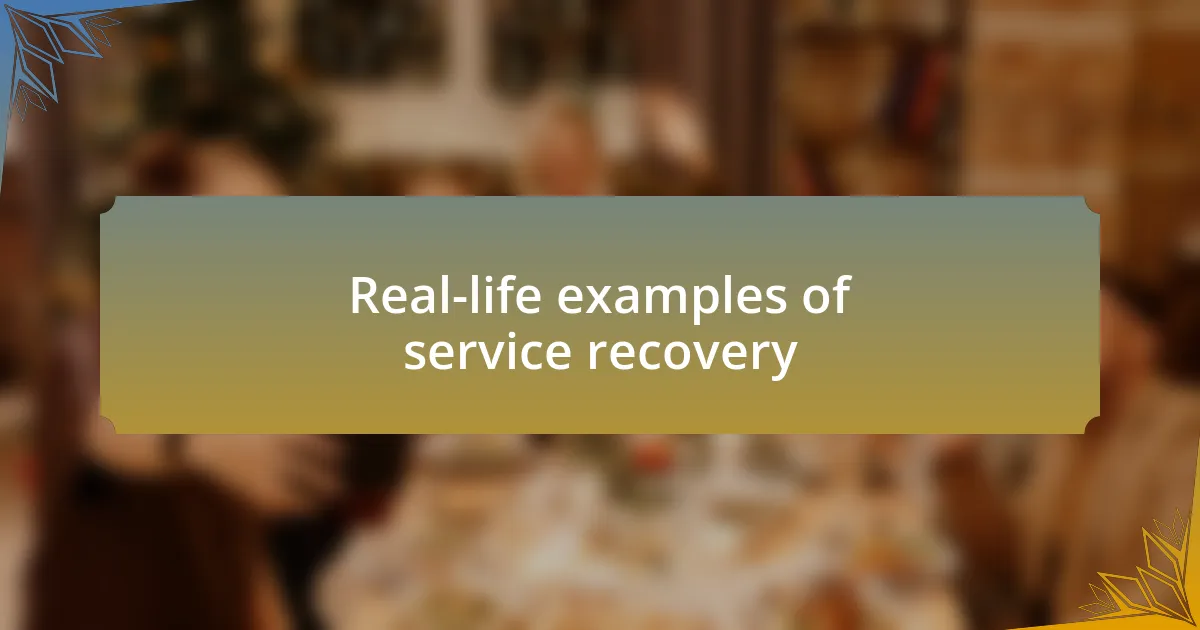
Real-life examples of service recovery
I once encountered a situation at a local coffee shop where my order was completely wrong. Instead of just correcting the mistake, the barista apologized eagerly, offered me the right drink at no charge, and even threw in a pastry as a goodwill gesture. That small act transformed my frustration into gratitude, making me a loyal customer. Have you ever felt that level of appreciation for simply being heard?
Another noteworthy example happened during a flight delay with an airline. After experiencing significant inconvenience, I was pleasantly surprised when the airline proactively offered meal vouchers and updates throughout the ordeal. This genuine effort to ease a stressful situation made all the difference for me. It made me wonder how often brands prioritize their customers’ comfort during unexpected challenges.
Lastly, I can’t forget how a national retailer handled my complaint about a defective product. Instead of merely replacing it, they took the time to understand my experience and offered me a discount on my next purchase as well. This thoughtful gesture not only resolved my issue but also left me feeling valued and appreciated as a customer. Have you ever had a brand go above and beyond in a similar way?
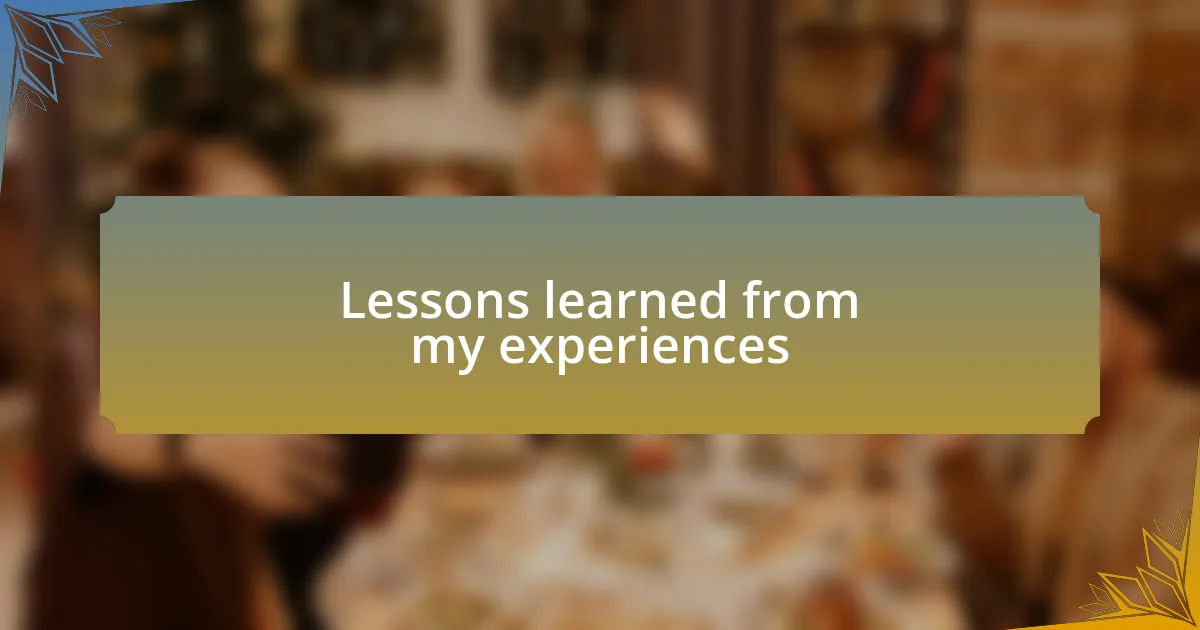
Lessons learned from my experiences
In my journey, I’ve learned that genuine empathy can turn a service failure into a remarkable opportunity. I remember a while back when a hotel misplaced my reservation. Instead of dismissing the issue, the manager not only found me a room but also offered a complimentary upgrade, along with breakfast the next morning. That experience taught me that acknowledging the customer’s feelings is vital—it’s about more than just fixing a mistake.
Another lesson surfaced during a particularly challenging interaction with a tech support team. After waiting on hold for what felt like ages, I finally reached someone who patiently listened to my frustrations. Their willingness to guide me step-by-step through the solution was refreshing. It made me realize how transparency and clear communication can diffuse tension. Have you ever noticed how an understanding voice can change your entire perspective?
Moreover, I fondly recall a trip to a car service center where my vehicle was unexpectedly delayed. Instead of leaving me in the dark, the staff regularly checked in and offered refreshments while I waited. Their proactive approach highlighted the importance of keeping customers informed, no matter the situation. Do you think we often underestimate the power of simple yet thoughtful gestures in enhancing customer experience?